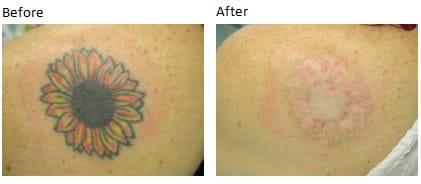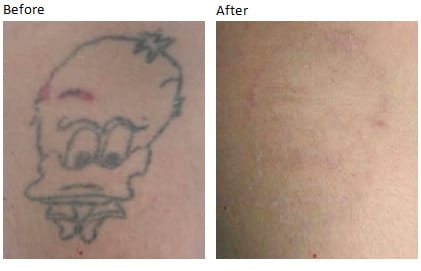Tattoo Removal
A tattoo may seem like a good idea at the time, but you might regret the decision later on. Laser treatment can safely and highly effectively remove your tattoo. No single laser can remove all types of tattoo ink. Beauty Within Cosmetic Clinic offers two laser systems to ensure optimal tattoo removal. Q-switched ND:Yag for removal of dark blue, black, grey and white ink. The Q-switched KTP laser for red, purple, orange and brown ink. The removal of a multicoloured tattoo requires the use of these two different laser systems in combination to ensure superior results.
Tattoo Removal – The Facts
Leading plastic surgeons and dermatologists regard laser as the superior method for the safe removal of amateur and professional tattoos.
How does the laser work?
Tattoo ink particles are too large for the body’s immune system to remove naturally. By passing a very short pulse of high power laser light through the skin, the tattoo ink is broken into smaller particles, which the body is able to remove.


How many treatments are required to remove a tattoo?
Most amateur tattoos require 3-5 sessions at monthly intervals. Most professional tattoos require 8-15 treatment sessions at monthly intervals.
Do all tattoos respond to treatment?
In the majority of cases we are able to remove most tattoos. No one laser can remove all types of tattoo ink, which is why we use two different lasers on site to ensure optimal results.
What are the costs likely to be?
The cost of each session depends on the size and colour of the tattoo. The total cost of tattoo removal depends on the number of treatments needed and this varies considerably from patient to patient.
How long does it take and does it hurt?
Typical treatment sessions last between 5-14 minutes depending on the size of the tattoo. The lasers do cause discomfort during treatment, similar to being “snapped” with a rubber band. Most patients equate the pain of tattoo removal with the pain of getting the tattoo. Some areas are more sensitive than others, such as ankles and the shoulder blade. The pain tends to decrease as treatment progresses and tattoo ink fades. Most patients tolerate the discomfort of treatment very well, but a local anaesthetic is available if required.
Are there any after-effects following treatment?
Redness and swelling may occur, similar to sunburn. This settles within a few days. Some patients may blister, which is quite normal and does not indicate potential scarring. Blistering does not require treatment and will usually clear within days. Please refer to the blister advice sheet. The treated area should not be exposed to strong sunlight between sessions without the use of sunblock (SPF 30).
Does the treatment scar?
Our lasers are Q-switched, which means the lasers deliver high power in a very short pulse (25 billionths of a second!). Although scarring can occur there is normally no lasting damage to the skin. Very occasionally, mild changes in skin texture may occur.
Will the skin be normal when the treatment is finished?
KTP lasers are absorbed by skin pigment as well as tattoo ink. Darker skinned patients may notice some lightening of the skin (depigmentation). This usually returns to normal in 6-12 months. We tend to limit treatment for darker skinned patients to the Nd:YAG laser as the risk of pigment change is less.
Is laser treatment safe?
There is no evidence whatsoever to suggest that the treatment can lead to skin disorders or an increased risk of cancer. Our laser centre is registered with the Healthcare Commission ensuring the highest level of safety for the patient. Please note: prices quoted are per session and are an approximate guide. They relate to solid blocks of tattoo pigment and not tattoo size. If you require a more accurate pricing prior to consultation, please contact us directly. Prices are normally fixed for sessions 3-12. Sessions 12-15 are at a reduced price if the area needing treatment is significantly reduced. Although laser treatment for tattoos may seem expensive, one must bear in mind the enormous acquisition and maintenance costs of the laser devices.